Phase Equilibria of the Mg-Zn-Sm System in Mg-Rich Corner at 320 °C and 400 °C
Abstract
:1. Introduction
2. Materials and Methods
3. Results
3.1. Microstructures of the As-Cast Mg-Zn-Sm Alloys
3.2. Phase Equilibria in Mg-Rich Corner at 400 and 320 °C
3.3. Crystal Structure of the Ternary Compounds
3.4. Thermodynamic Calculation of the Mg-Zn-Sm System
4. Conclusions
- (1)
- The Mg3Sm phase is a linear compound, which can dissolve up to 49.2 at.% Zn at 400 °C. Ternary compounds Y (Mg62Zn31Sm7) and τ (Mg36Zn50Sm14) are observed in the as-cast alloys. The Y phase is determined to have an orthorhombic structure with lattice parameters of a = 10.20 Å, b = 11.26 Å and c = 9.64 Å by TEM, yet the structure of τ is still unknown. The hexagonal compound μ7 is a transition phase and can only be detected during the transformation of the Y phase to the stable Z phase in the alloys located in the (Mg) + Mg3Sm + Z region.
- (2)
- The phase equilibria (Mg) + Mg41Sm5 + Mg3Sm, (Mg) + Mg3Sm + Z and (Mg) + Z + liquid are confirmed at 400 °C in the Mg-rich corner, while the (Mg) + Z + MgZn three-phase region exists in the Mg-Zn side at 320 °C. The calculated phase diagrams agree well with the experimental data.
- (3)
- The ternary compound Y was frequently observed in the as-cast alloys, even in the alloy located in the primary crystal region of the Z phase. By suppressing the stale Z phase, the calculated liquidus projection containing the Y phase and non-equilibrium solidification simulation can reasonably explain the as-cast structure of alloys in the Mg-rich corner.
Author Contributions
Funding
Institutional Review Board Statement
Informed Consent Statement
Data Availability Statement
Acknowledgments
Conflicts of Interest
References
- Song, J.; Chen, J.; Xiong, X.; Peng, X.; Chen, D.; Pan, F. Research advances of magnesium and magnesium alloys worldwide in 2021. J. Magnes. Alloy. 2022, 10, 863–898. [Google Scholar] [CrossRef]
- Zhang, Z.; Zhang, J.H.; Wang, J.; Li, Z.H.; Xie, J.S.; Liu, S.J.; Guan, K.; Wu, R.Z. Toward the development of Mg alloys with simultaneously improved strength and ductility by refining grain size via the deformation process. Int. J. Miner. Metall. Mater. 2021, 28, 30–45. [Google Scholar] [CrossRef]
- Jono, Y.; Yamasaki, M.; Kawamura, Y. Quantitative evaluation of creep strain distribution in an extruded Mg-Zn-Gd alloy of multimodal microstructure. Acta Mater. 2015, 82, 198–211. [Google Scholar] [CrossRef]
- Ebenezer, D.; Rao, S.R. Impression Creep Behavior of an Mg-Zn-RE Alloy at Elevated Temperatures. Metall. Mater. Trans. A 2022, 53, 823–836. [Google Scholar] [CrossRef]
- Ishiguro, Y.; Huang, X.; Tsukada, Y.; Koyama, T.; Chino, Y. Effect of bending and tension deformation on the texture evolution and stretch formability of Mg-Zn-RE-Zr alloy. Int. J. Miner. Metall. Mater. 2022, 29, 1334–1342. [Google Scholar] [CrossRef]
- Kang, W.; Lu, L.; Feng, L.; Lu, F.; Gan, C.; Li, X. Effects of pre-aging on microstructure evolution and deformation mechanisms of hot extruded Mg-6Zn-1Gd-1Er Mg alloys. J. Magnes. Alloy. 2021; in press. [Google Scholar] [CrossRef]
- Egusa, D.; Abe, E. The structure of long period stacking/order Mg-Zn-RE phases with extended non-stoichiometry ranges. Acta Mater. 2012, 60, 166–178. [Google Scholar] [CrossRef]
- Hagihara, K.; Okamoto, T.; Izuno, H.; Yamasaki, M.; Matsushita, M.; Nakano, T.; Kawamura, Y. Plastic deformation behavior of 10H-type synchronized LPSO phase in a Mg-Zn-Y system. Acta Mater. 2016, 109, 90–102. [Google Scholar] [CrossRef]
- Hua, X.; Yang, Q.; Zhang, D.; Meng, F.; Chen, C.; You, Z.; Zhang, J.; Lv, S.; Meng, J. Microstructures and mechanical properties of a newly developed high-pressure die casting Mg-Zn-RE alloy. J. Mater. Sci. Technol. 2020, 53, 174–184. [Google Scholar] [CrossRef]
- Tian, Y.; Huang, H.; Yuan, G.; Ding, W. Microstructure evolution and mechanical properties of quasicrystal-reinforced Mg-Zn-Gd alloy processed by cyclic extrusion and compression. J. Alloys Compd. 2015, 626, 42–48. [Google Scholar] [CrossRef]
- Wang, W.Z.; Zhou, X.Z.; Zhang, L.F.; Ye, H.Q.; Yang, Z.Q. Precipitation of multi-type nano-quasicrystals in a Mg-Zn-Y alloy. J. Magnes. Alloy. 2022; in press. [Google Scholar] [CrossRef]
- Guan, K.; Li, B.; Yang, Q.; Qiu, X.; Tian, Z.; Zhang, D.; Zhang, D.; Niu, X.; Sun, W.; Liu, X.; et al. Effects of 1.5 wt% samarium (Sm) addition on microstructures and tensile properties of a Mg-6.0Zn-0.5Zr alloy. J. Alloys Compd. 2018, 735, 1737–1749. [Google Scholar] [CrossRef]
- Zhang, D.; Yang, Q.; Zhang, D.; Guan, K.; Bu, F.; Zhou, H.; Meng, J. Effects of substitution of Nd in a sand-cast Mg-2.5 Nd-0.6 Zn-0.5 Zr alloy with x wt.% Sm (x= 2.5, 4, and 6). J. Rare Earths 2017, 35, 1261–1267. [Google Scholar] [CrossRef]
- Che, C.; Cai, Z.; Cheng, L.; Meng, F.; Yang, Z. The microstructures and tensile properties of as-extruded Mg-4Sm-xZn-0.5 Zr (x = 0, 1, 2, 3, 4 wt%) alloys. Metals 2017, 7, 281. [Google Scholar] [CrossRef]
- Zhang, Y.; Huang, X.; Ya, L.; Zhenduo, M.; Ying, M.; Yuan, H. Effects of samarium addition on as-cast microstructure, grain refinement and mechanical properties of Mg-6Zn-0.4 Zr magnesium alloy. J. Rare Earths 2017, 35, 494–502. [Google Scholar] [CrossRef]
- Guan, K.; Meng, F.; Qin, P.; Yang, Q.; Zhang, D.; Li, B.; Sun, W.; Lv, S.; Huang, Y.; Hort, N.; et al. Effects of samarium content on microstructure and mechanical properties of Mg-0.5 Zn-0.5 Zr alloy. J. Mater. Sci. Technol. 2019, 35, 1368–1377. [Google Scholar] [CrossRef]
- Drits, M.E.; Rokhlin, L.L.; Abrukina, N.P. Phase equilibria in Mg-Sm-Zn system. Izv. Akad. Nauk. SSSR Met. 1985, 6, 194–200. [Google Scholar]
- Sugiyama, K.; Yasuda, K.; Ohsuna, T.; Hiraga, K. The structures of hexagonal phases in Mg-Zn-RE (RE = Sm and Gd) alloys. Z. Krist. Cryst. Mater. 1998, 213, 537–543. [Google Scholar] [CrossRef]
- Abe, E.; Takakura, H.; Singh, A.; Tsai, A.P. Hexagonal superstructures in the Zn-Mg-rare-earth alloys. J. Alloys Compd. 1999, 283, 169–172. [Google Scholar] [CrossRef]
- Sugiyama, K.; Yasuda, K.; Horikawa, Y.; Ohsuna, T.; Hiraga, K. Crystal structure of μ7-MgZnSm. J. Alloys Compd. 1999, 285, 172–178. [Google Scholar] [CrossRef]
- Abe, E.; Tsai, A.P. Quasicrystal-crystal transformation in Zn-Mg–rare-earth alloys. Phys. Rev. Lett. 1999, 83, 753. [Google Scholar] [CrossRef]
- Xia, X.; Sanaty-Zadeh, A.; Zhang, C.; Luo, A.A.; Zeng, X.; Chang, Y.A.; Stone, D.S. Thermodynamic modeling and experimental investigation of the magnesium-zinc-samarium alloys. J. Alloys Compd. 2014, 593, 71–78. [Google Scholar] [CrossRef]
- Zhu, Z.; Pelton, A.D. Thermodynamic modeling of the La-Mg-Zn, Pr-Mg-Zn and Sm-Mg-Zn system. J. Alloys Compd. 2015, 652, 415–425. [Google Scholar] [CrossRef]
- Cao, W.; Chen, S.L.; Zhang, F.; Wu, K.; Yang, Y.; Chang, Y.A.; Schmid-Fetzer, R.; Oates, W.A. PANDAT software with PanEngine, PanOptimizer and PanPrecipitation for multi-component phase diagram calculation and materials property simulation. Calphad 2009, 33, 328–342. [Google Scholar] [CrossRef]
- Jia, B.R.; Liu, L.B.; Yi, D.Q.; Jin, Z.P.; Nie, J.F. Thermodynamic assessment of the Al-Mg-Sm system. J. Alloys Compd. 2008, 459, 267–273. [Google Scholar] [CrossRef]
- Ghosh, P.; Mezbahul-Islam, M.D.; Medraj, M. Critical assessment and thermodynamic modeling of Mg-Zn, Mg-Sn, Sn-Zn and Mg-Sn-Zn systems. Calphad 2012, 36, 28–43. [Google Scholar] [CrossRef]
- Liu, X.J.; Chen, X.; Wang, C.P. Thermodynamic assessments of the Sm-Zn and Nd-Zn systems. J. Alloys Compd. 2009, 468, 115–121. [Google Scholar] [CrossRef]
- Luo, Q.; Zhai, C.; Sun, D.; Chen, W.; Li, Q. Interpolation and extrapolation with the CALPHAD method. J. Mater. Sci. Technol. 2019, 35, 2115–2120. [Google Scholar] [CrossRef]
- SGTE Unary Database. Version 5.0-Scientifific Group Thermodata Europe, Grenoble. 2009. Available online: https://www.sgte.net/en/free-pure-substance-database (accessed on 16 September 2022).
- Redlich, O.; Kister, A.T. Algebraic representation of thermodynamic properties and the classification of solutions. Ind. Eng. Chem. 1948, 40, 345–348. [Google Scholar] [CrossRef]
- Muggianu, Y.M.; Gambino, M.; Bros, J.P. Enthalpies of formation of liquid alloys bismuth-gallium-tin at 723k-choice of an analytical representation of integral and partial thermodynamic functions of mixing for this ternary-system. J. Chim. Phys. Phys.-Chim. Biol. 1975, 72, 83–88. [Google Scholar] [CrossRef]
- Hillert, M. The compound energy formalism. J. Alloys Compd. 2001, 320, 161–176. [Google Scholar] [CrossRef]
- Saccone, A.; Delfino, S.; Borzone, G.; Ferro, R. The samarium-magnesium system: A phase diagram. J. Less Common Met. 1989, 154, 47–60. [Google Scholar] [CrossRef]
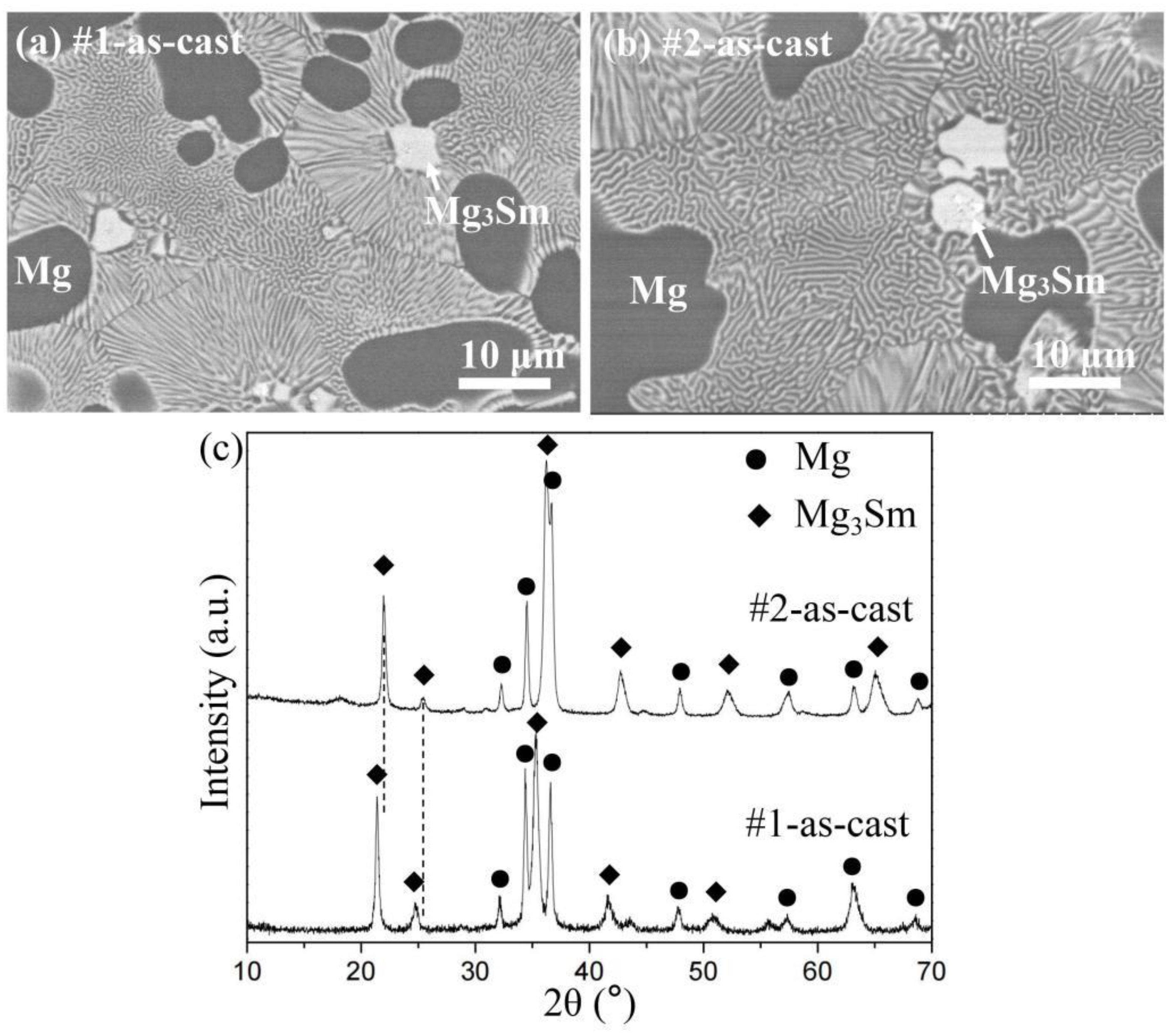
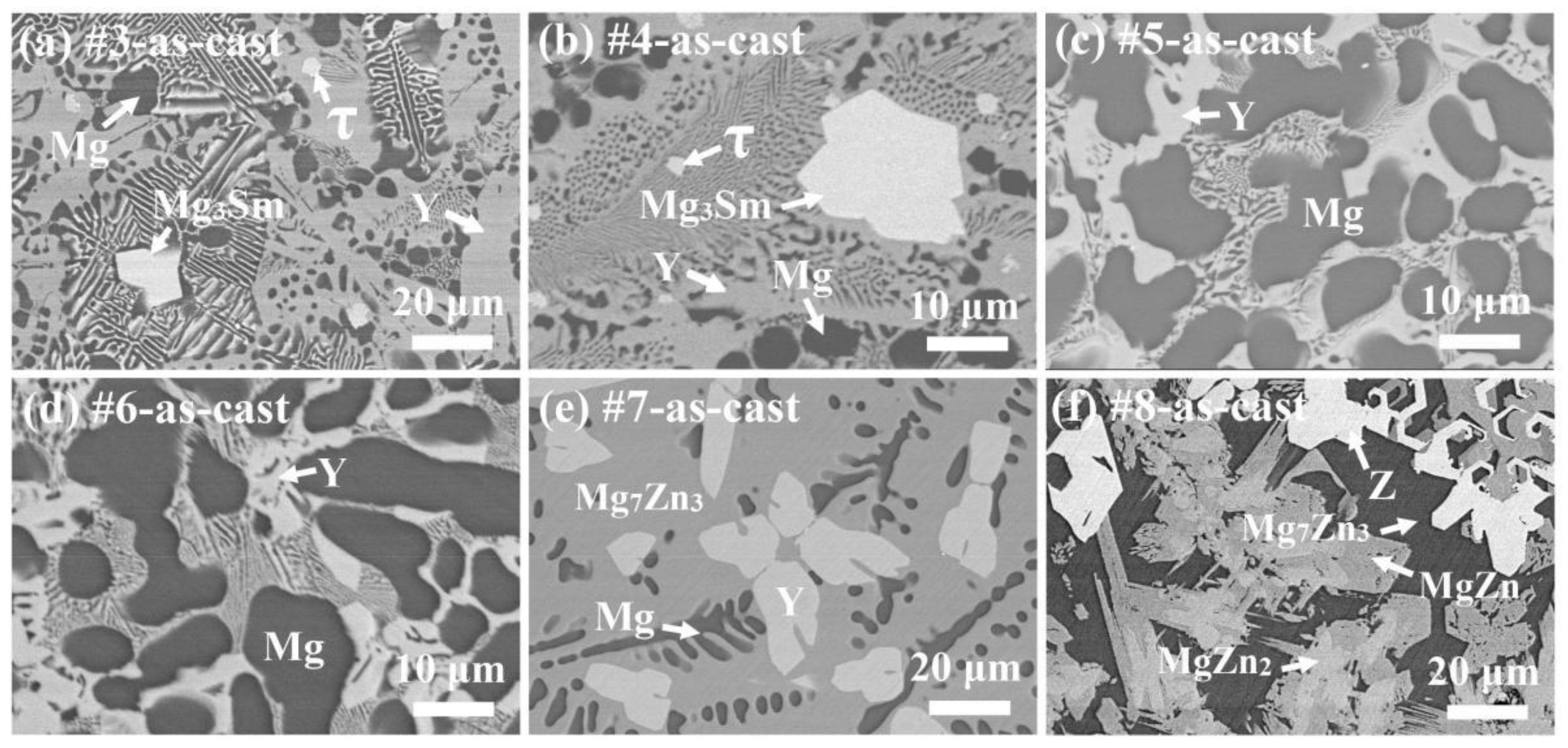
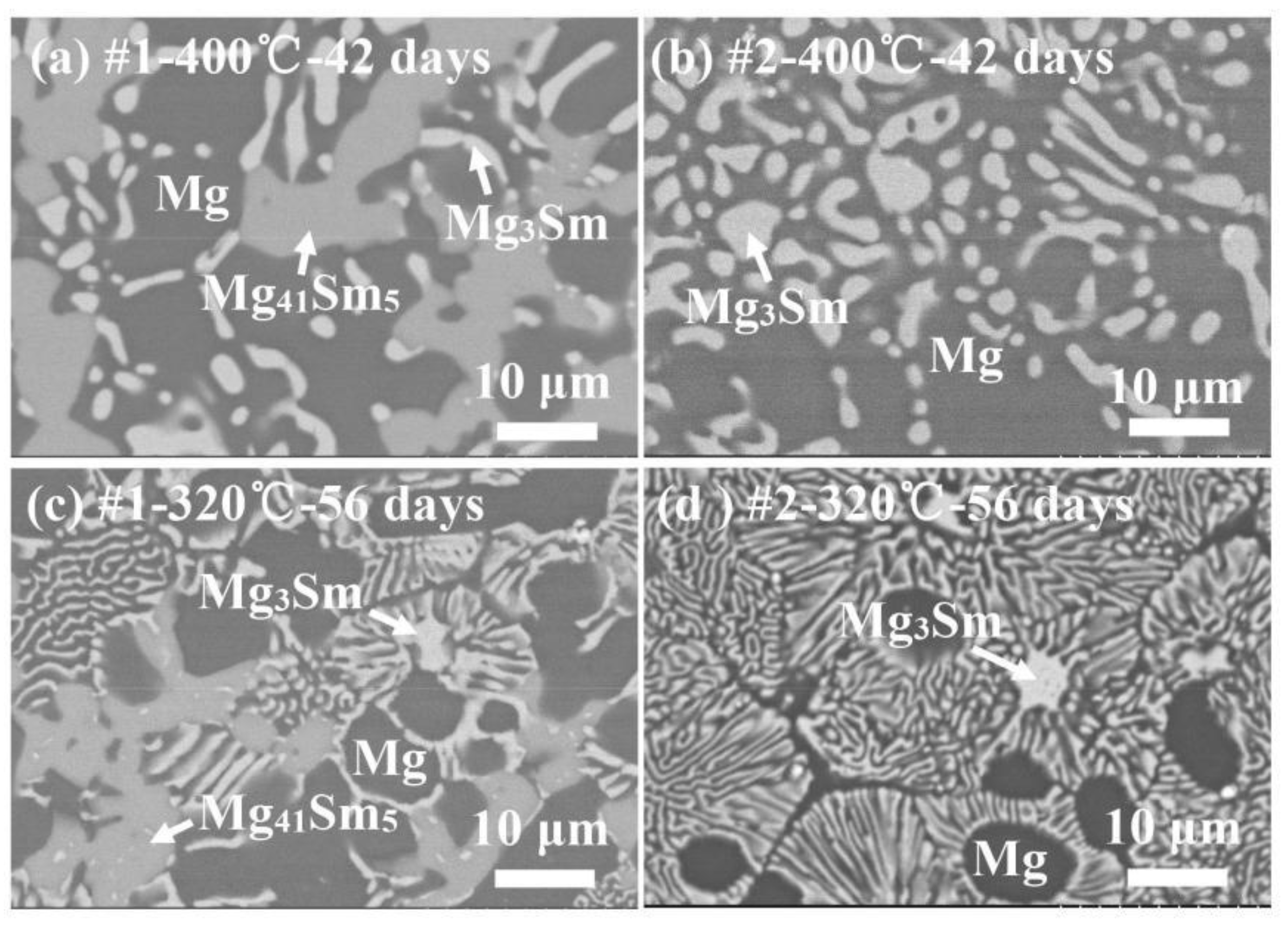
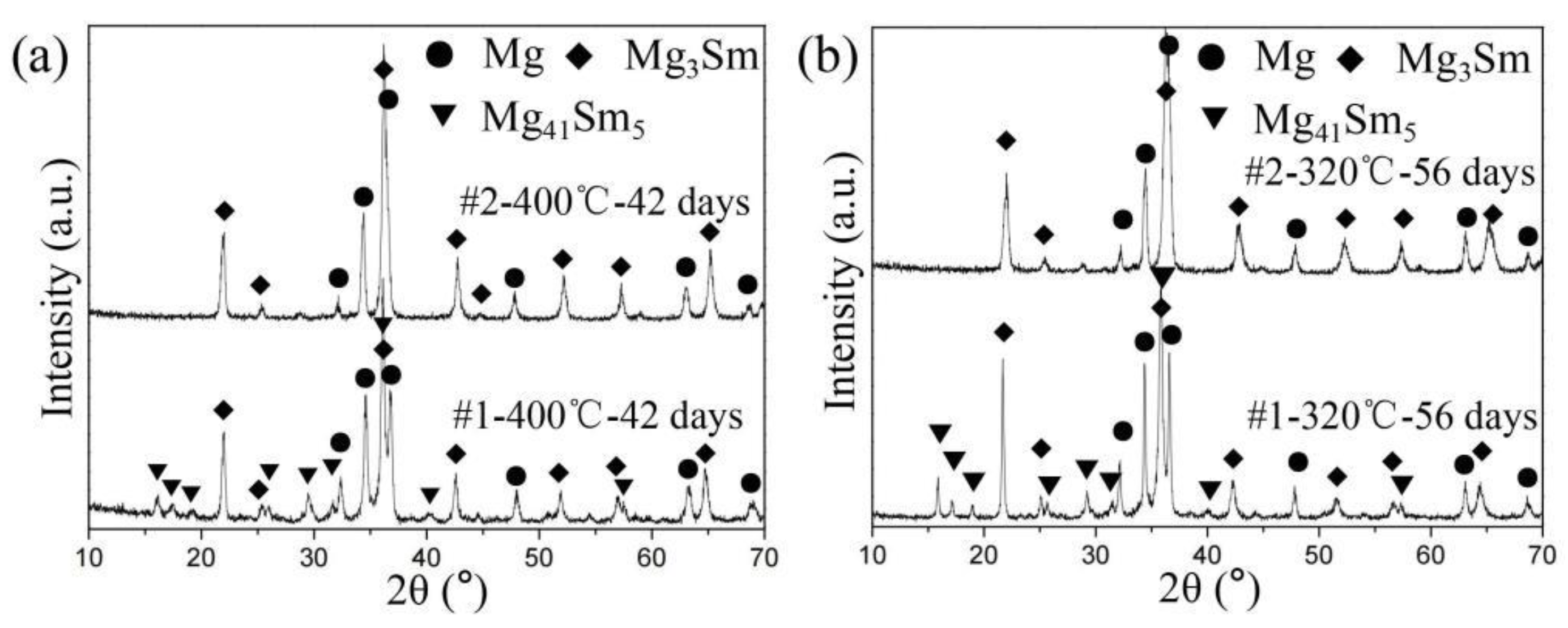
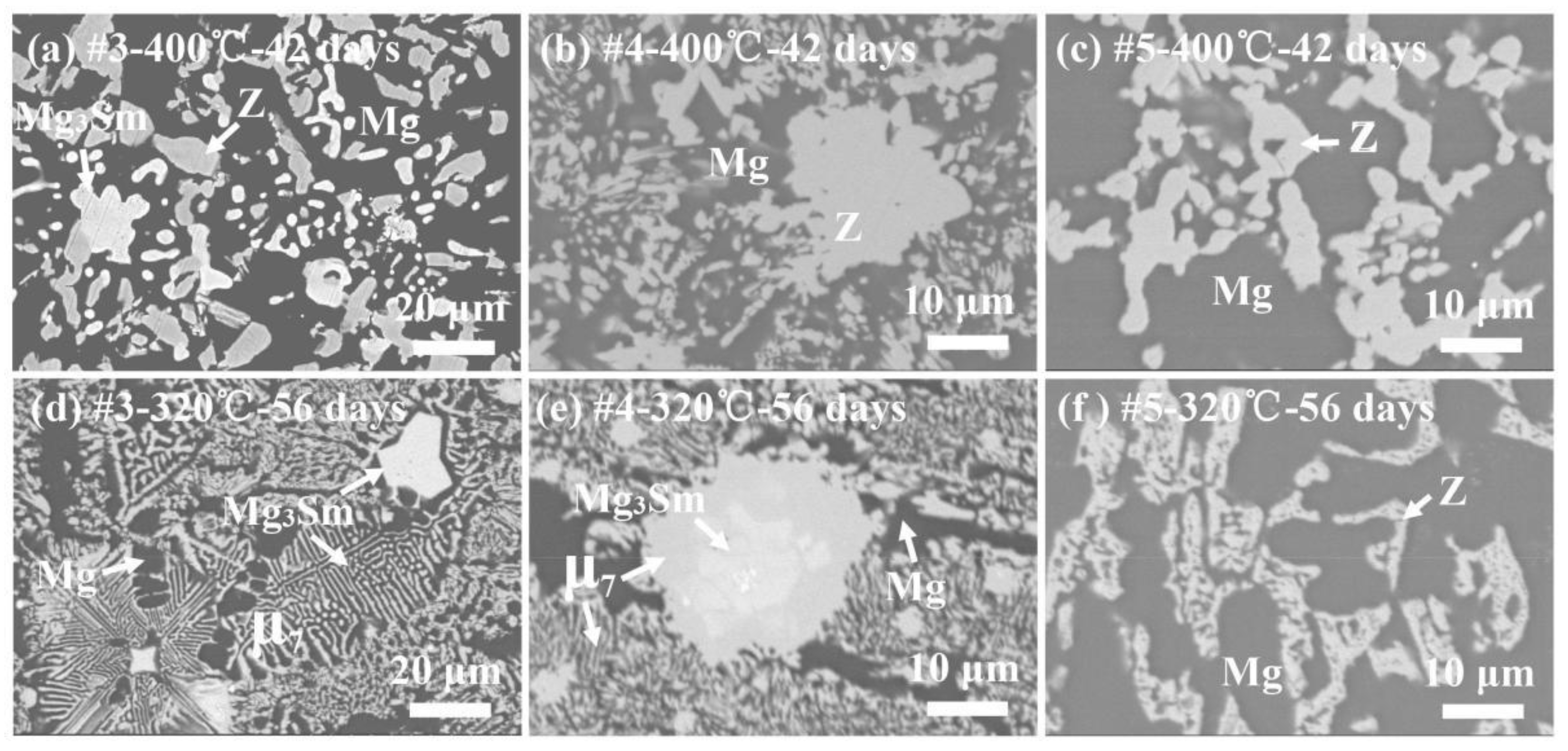
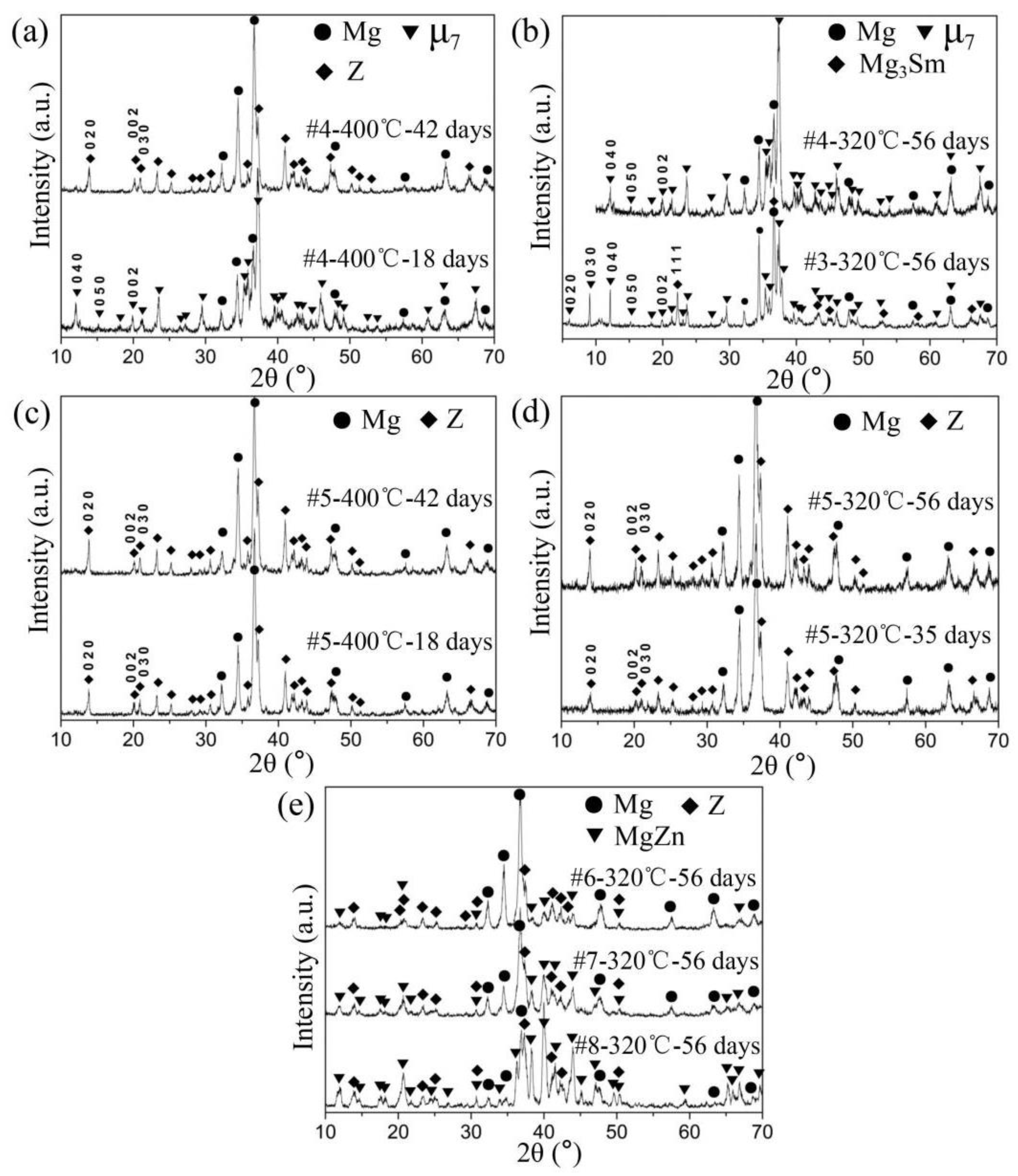
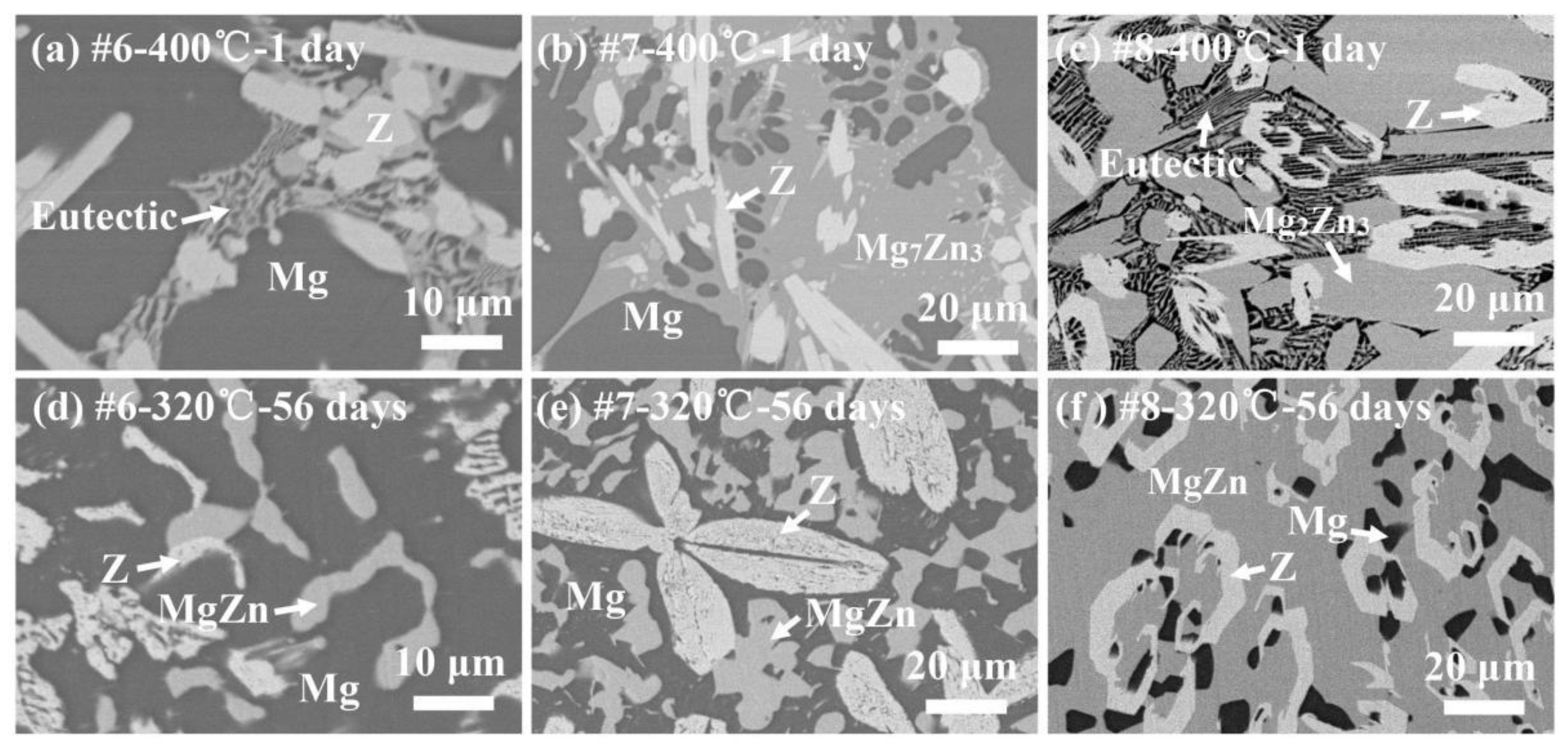
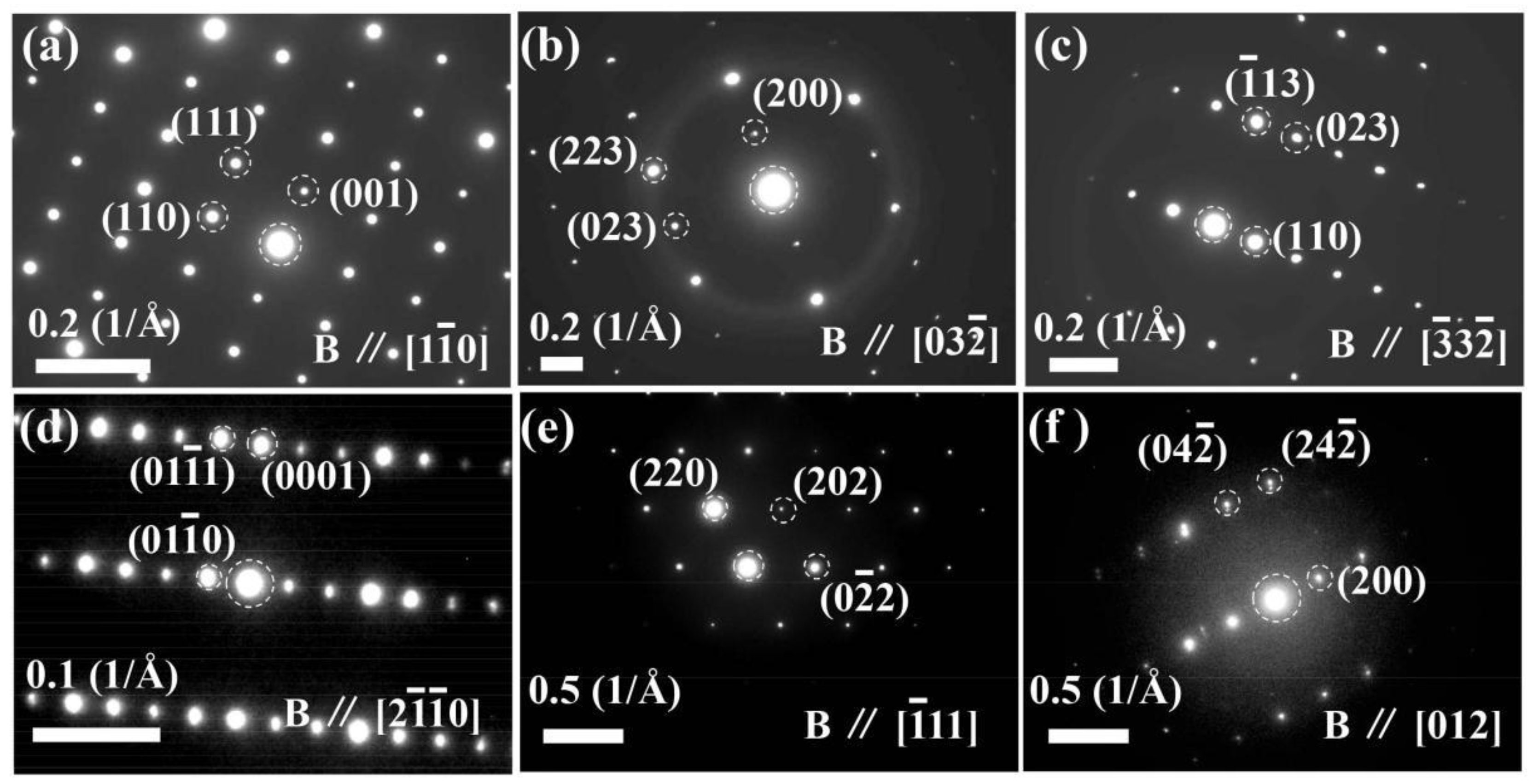
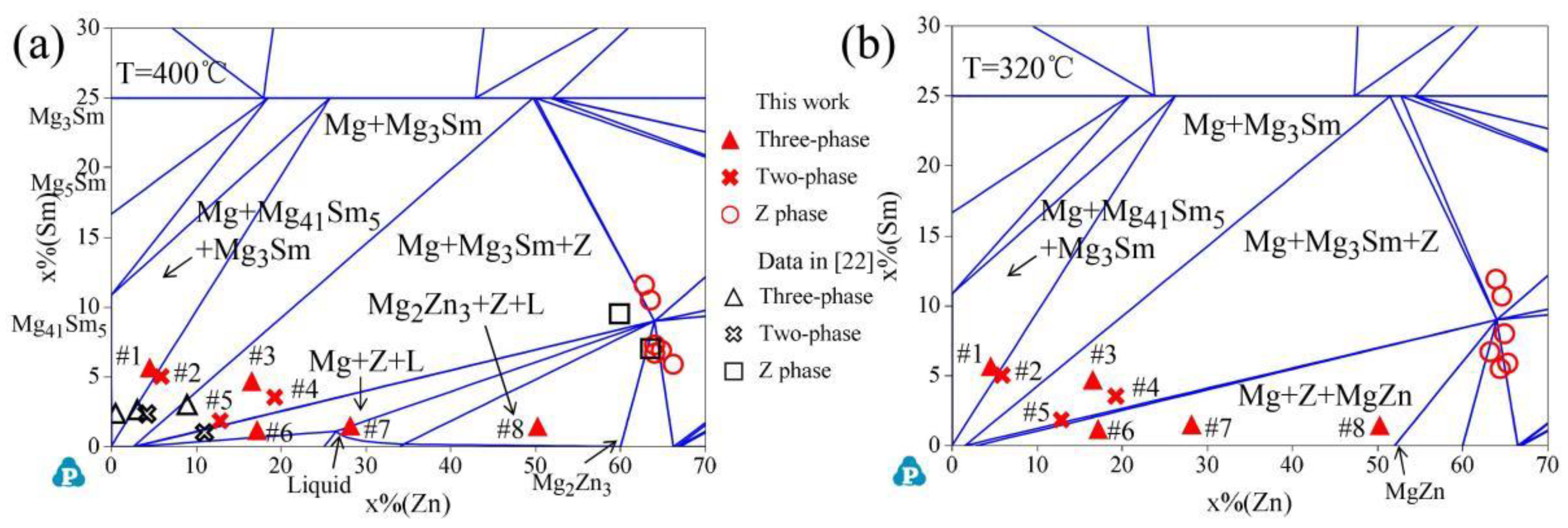

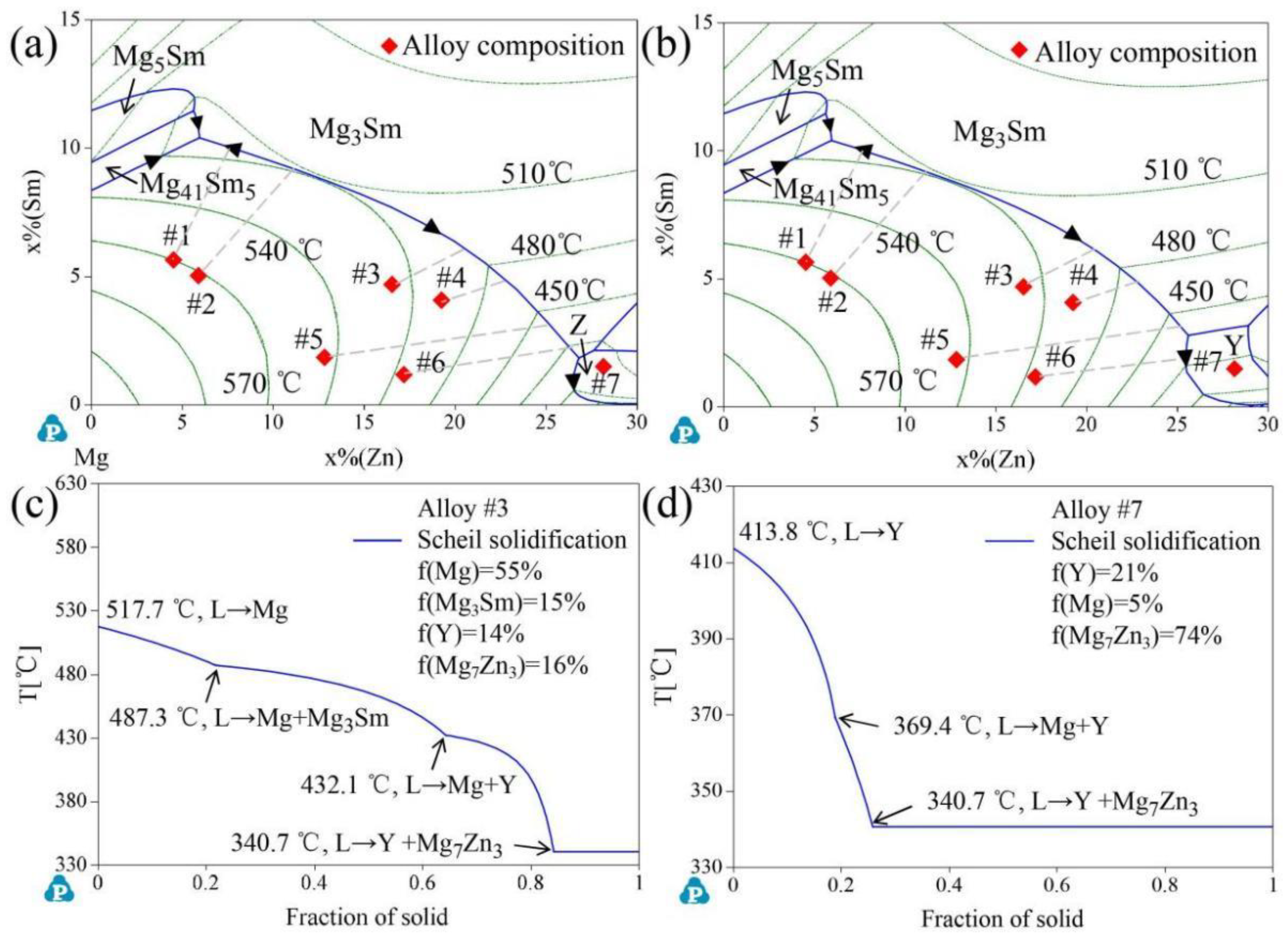
| Phase | Phase Composition (at.%) | Crystal Structure | Lattice Parameters (Å) | References |
|---|---|---|---|---|
| X | Mg51.8Zn23.3Sm24.9 | FCC | a = 6.907 | [17] |
| Mg3Sm | Mg34.3–47.6Zn30.9–45.4Sm19.4–26.4 | FCC | a = 6.64–6.94 | [22] |
| Y | Mg51.8Zn23.3Sm24.9 | Unknown | Unknown | [17] |
| Z | Mg29.1Zn60.6Sm10.3 | HCP | a = 14.62, c = 8.78 | [17] |
| Z | Mg29.6–37.0Zn57.3–63.5Sm5.7–9.5 | HCP, P63/mmc | a = 14.62, c = 8.71 | [22] |
| μ3 | Mg28.3Zn65.2Sm6.5 | HCP, P63/mmc | a = 14.619, c = 8.708 | [18] |
| μ5 | Mg24.2Zn65.3Sm10.5 | HCP, P63/mmc | a = 23.5, c = 8.6 | [19] |
| μ7 | Mg24.7Zn63.5Sm11.8 | HCP, P63/mmc | a = 33.565, c = 8.873 | [20] |
| No. | Alloy Composition (at.%) | Treatment Condition | Phases | Phase Composition (at.%) | ||
|---|---|---|---|---|---|---|
| Mg | Sm | Zn | ||||
| #1 | Mg-5.7Sm-4.5Zn | 320 °C/56 days | (Mg) | 99.7 | 0.1 | 0.2 |
| Mg41Sm5 | 88.6 | 10.5 | 0.9 | |||
| Mg3Sm | 50.0 | 21.7 | 28.3 | |||
| 400 °C/42 days | (Mg) | 99.6 | 0.4 | - | ||
| Mg41Sm5 | 88.0 | 10.2 | 1.8 | |||
| Mg3Sm | 48.9 | 20.9 | 30.2 | |||
| #2 | Mg-5.0Sm-5.9Zn | 320 °C/56 days | (Mg) | 100 | - | - |
| Mg3Sm | 40.3 | 21.5 | 38.2 | |||
| 400 °C/42 days | (Mg) | 100 | - | - | ||
| Mg3Sm | 41.4 | 20.7 | 37.9 | |||
| #3 | Mg-4.7Sm-16.7Zn | 320 °C/56 days | (Mg) | 98.8 | - | 1.2 |
| Mg3Sm | 28.9 | 22.4 | 48.7 | |||
| μ7 | 27.2 | 10.8 | 62.0 | |||
| 400 °C/42 days | (Mg) | 97.8 | - | 2.2 | ||
| Mg3Sm | 29.3 | 21.5 | 49.2 | |||
| Z | 25.2 | 11.8 | 63.0 | |||
| #4 | Mg-4.1Sm-19.3Zn | 320 °C/56 days | (Mg) | 98.9 | - | 1.1 |
| μ7 | 26.4 | 10.2 | 63.4 | |||
| Mg3Sm | 29.4 | 21.5 | 49.1 | |||
| 400 °C/42 days | (Mg) | 97.2 | - | 2.8 | ||
| Z | 26.6 | 10.1 | 63.3 | |||
| #5 | Mg-1.8Sm-12.8Zn | 320 °C/56 days | (Mg) | 98.4 | - | 1.6 |
| Z | 33.4 | 6.6 | 60.0 | |||
| 400 °C/42 days | (Mg) | 97.0 | - | 3.0 | ||
| Z | 30.7 | 7.1 | 62.2 | |||
| #6 | Mg-1.2Sm-17.2Zn | 320 °C/56 days | (Mg) | 97.2 | - | 2.8 |
| Z | 31.7 | 5.1 | 63.2 | |||
| MgZn | 48.6 | - | 51.4 | |||
| 400 °C/1 day | (Mg) | 96.5 | - | 3.5 | ||
| Z | 29.5 | 6.6 | 63.9 | |||
| Liquid | - | - | - | |||
| #7 | Mg-1.5Sm-28.1Zn | 320 °C/56 days | (Mg) | 97.2 | - | 2.8 |
| Z | 32.3 | 6.1 | 61.6 | |||
| MgZn | 48.7 | - | 51.3 | |||
| 400 °C/1 day | (Mg) | 96.3 | - | 3.7 | ||
| Z | 29.3 | 6.6 | 64.1 | |||
| Liquid | - | - | - | |||
| #8 | Mg-1.4Sm-50.2Zn | 320 °C/56 days | (Mg) | 97.0 | - | 3.0 |
| Z | 29.5 | 5.4 | 65.1 | |||
| MgZn | 48.7 | - | 51.3 | |||
| 400 °C/1 day | Mg2Zn3 | 40.4 | - | 59.6 | ||
| Z | 27.9 | 5.9 | 66.2 | |||
| Liquid | - | - | - | |||
| Liquid: substitutional solution, (Mg, Zn, Sm)1 |
| = −85,000 |
| HCP: substitutional solution, (Mg, Zn, Sm)1 |
| = 2500 − 8.5 T |
| = −5050 |
| Mg41Sm5: stoichiometric, (Mg)0.8913(Sm)0.1087 |
| − 4522.4 + 0.1076T |
| Mg3Sm: CEF, (Mg, Zn)0.55(Mg)0.2(Sm)0.25 |
| − 47707.79 + 25.26 T |
| = −7535.79 + 8.42 T |
| = 5583.889 + 0.756 T |
| Y: stoichiometric, (Mg)0.62(Zn)0.31(Sm)0.07 |
| − 16007.76 + 6.088 T |
| Z: stoichiometric, (Mg)0.27(Zn)0.64(Sm)0.09 |
| − 24419.6 + 7.63 T |
| Invariant Reactions | T (°C) | Notes/Reference | Composition (at.%) | ||
|---|---|---|---|---|---|
| Mg | Sm | Zn | |||
| L→(Mg) + Mg41Sm5 + Mg3Sm | 497.1 | this work | 83.65 | 5.94 | 10.41 |
| 515 | exp. [17] | 87.9 | 2.8 | 9.3 | |
| 502.4 | cal. [22] | 84.94 | 6.92 | 8.14 | |
| 489 | cal. [23] | - | - | - | |
| L + Mg3Sm→(Mg) + Z | 406.4 | this work | 71.39 | 26.81 | 1.82 |
| 405 | exp. [17] | 73.4 | 24.8 | 1.8 | |
| 419.54 | cal. [22] | 74.16 | 24.14 | 1.7 | |
| 357 | cal. [23] | - | - | - | |
| L + (Mg)→Mg7Zn3 + Z | 340.8 | this work | 70.91 | 29.06 | 0.03 |
| 340 | exp. [17] | 70.4 | 29.2 | 0.4 | |
| 340.98 | cal. [22] | 71.03 | 28.96 | 0.01 | |
| 343 | cal. [23] | - | - | - | |
| L + Mg3Sm→(Mg) + Y * | 432.2 | this work | 71.61 | 25.61 | 2.78 |
| 432 | exp. [17] | 73.6 | 22.1 | 4.3 | |
| 434 | cal. [23] | - | - | - | |
| L + (Mg)→Mg7Zn3 + Y * | 340.7 | this work | 70.82 | 29.12 | 0.06 |
Publisher’s Note: MDPI stays neutral with regard to jurisdictional claims in published maps and institutional affiliations. |
© 2022 by the authors. Licensee MDPI, Basel, Switzerland. This article is an open access article distributed under the terms and conditions of the Creative Commons Attribution (CC BY) license (https://creativecommons.org/licenses/by/4.0/).
Share and Cite
Yin, T.; Ma, Z.; Chen, H.; Luo, Q.; Zhang, J.; Wu, G. Phase Equilibria of the Mg-Zn-Sm System in Mg-Rich Corner at 320 °C and 400 °C. Metals 2022, 12, 1553. https://doi.org/10.3390/met12101553
Yin T, Ma Z, Chen H, Luo Q, Zhang J, Wu G. Phase Equilibria of the Mg-Zn-Sm System in Mg-Rich Corner at 320 °C and 400 °C. Metals. 2022; 12(10):1553. https://doi.org/10.3390/met12101553
Chicago/Turabian StyleYin, Tian, Zheng Ma, Hongcan Chen, Qun Luo, Jieyu Zhang, and Guangxin Wu. 2022. "Phase Equilibria of the Mg-Zn-Sm System in Mg-Rich Corner at 320 °C and 400 °C" Metals 12, no. 10: 1553. https://doi.org/10.3390/met12101553
APA StyleYin, T., Ma, Z., Chen, H., Luo, Q., Zhang, J., & Wu, G. (2022). Phase Equilibria of the Mg-Zn-Sm System in Mg-Rich Corner at 320 °C and 400 °C. Metals, 12(10), 1553. https://doi.org/10.3390/met12101553






